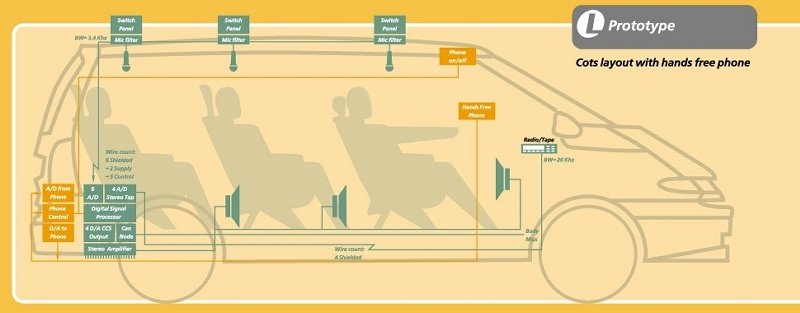|
Cabin
Communication System (CCS)
|
|
The Communication Technology Group of the University of Zaragoza (Spain) working together with the European Technological Center of Lear Corporation in Valls (Spain) are developing a Cabin Communication System (CCS) to improve the communication among passangers in mini-vans, sedans, and sport utility vehicles. Wind, road and engine noise and distance beween passengers make difficult
the communication inside vehicles. The cabin communication system has
the goal of increase the intelligibility of the passangers
communications without increase the noise, allowing the simultaneous
use of the high fidelity audio equipment. We understand as passangers
communications both the communication among passangers inside the vehicle
and the communication with outside people using a cellular phone. |
||
|
|
|
The proposed solution include: |
|
| Another features include: |
|
 |
|
|
|
|
|
The main features of the prototype are: |
||||
|
|
|
input channels | four microphones, two front seats, two rear seats. | |
|
|
output channels | two independent channels, one for left and right front loudspeakers and another for left and right rear loudspeakers. | ||
|
|
audio system | works with the audio systems installed in the vehicle allowing simultaneos use of the CCS and the radio equipment. | ||
|
|
cellular phone |
A hand-free telephone system is included to allow the simultaneous use of the inside communications capabilities of the CCS with a cellular phone. |
||
|
|
speech bandwidth | from 100 Hz up to 8000 Hz | ||
|
|
Acoustic reinforce | up to 10 dBA on the head position in the rear seats and up to 5 dBA in the front seats in a standard medium-size car. | ||
|
|
Speech samples mini-van |
engine
off
sequences of CCS ON-OFF (wav file) |
engine
on
sequences of CCS ON-OFF (wav file) |
|
Updated on 29th November 2000, Eduardo Lleida Solano